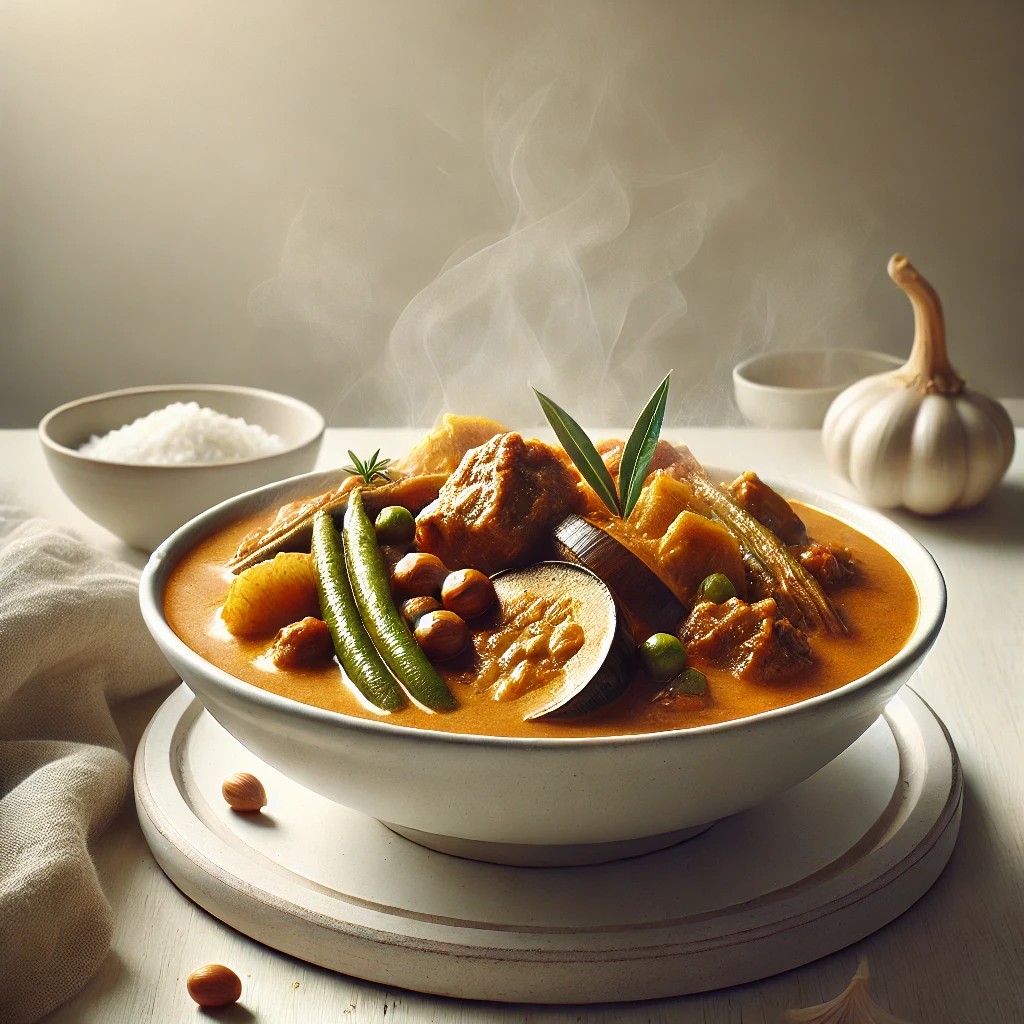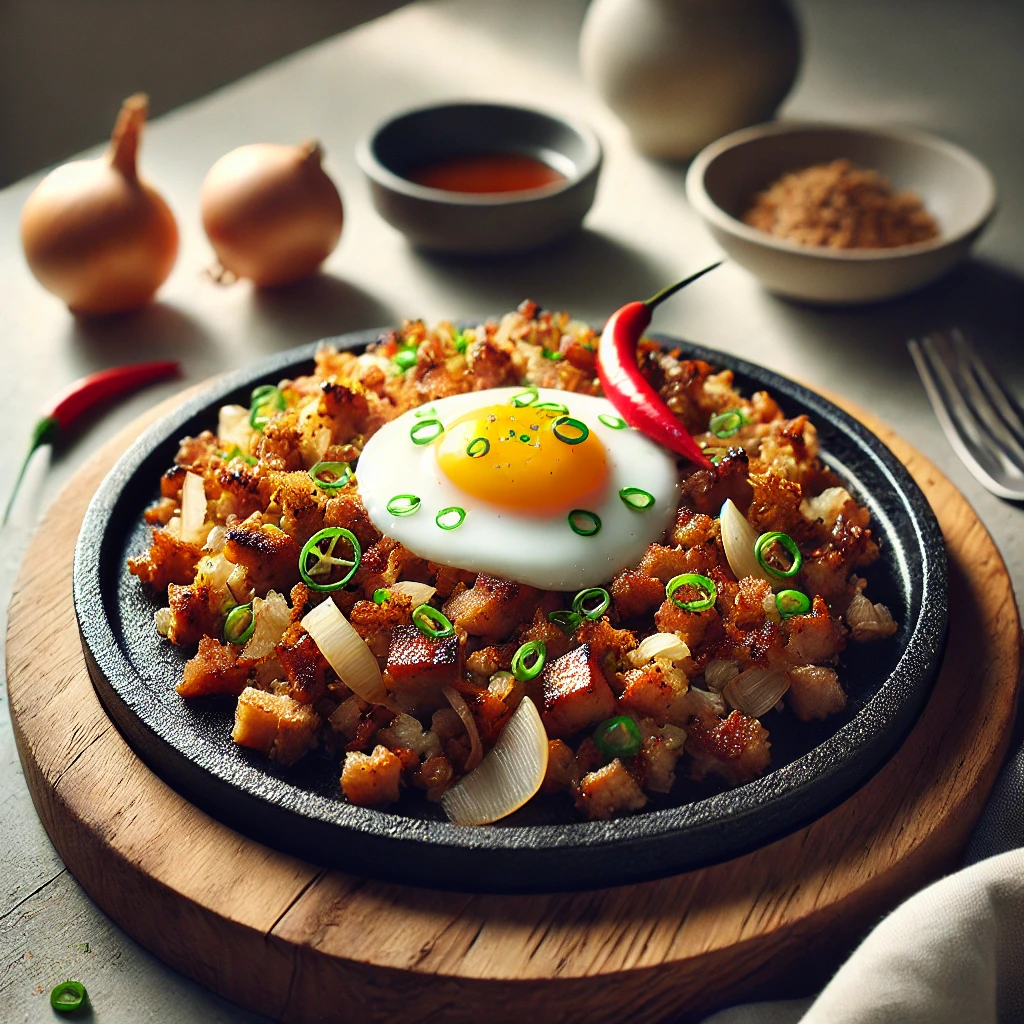Have you ever tasted a dish so rich and comforting that it instantly transports you to a place of warmth and celebration? That’s the magic of Kare-Kare, a beloved Filipino stew that has been gracing tables for generations. Picture this: tender chunks of meat and vibrant vegetables, all swimming in a lusciously thick, peanut-based sauce. The first time I tasted Kare-Kare, it was at a bustling family gathering in Manila. The moment the aromatic stew hit my taste buds, I knew I had discovered something truly special.
Kare-Kare isn’t just a meal; it’s a cultural experience. This hearty dish is a staple at Filipino celebrations, from birthdays to holidays, and has a way of bringing people together like few other recipes can. What sets Kare-Kare apart is its unique combination of savory and slightly sweet flavors, achieved through a careful balance of peanuts, annatto seeds, and various umami-rich ingredients. The result is a dish that’s both comforting and exciting, familiar yet exotic.
While traditionally made with oxtail or tripe, modern variations of Kare-Kare cater to various dietary preferences. Vegetarian and vegan versions exist, substituting meat with tofu or additional vegetables. For those with nut allergies, sunflower seed butter can be used as an alternative to peanut butter. This recipe is naturally gluten-free, making it accessible to those with gluten sensitivities. Whether you’re a meat lover, a vegetarian, or somewhere in between, there’s a version of Kare-Kare that’s sure to delight your palate.
Recipe Ingredients
Let’s dive into the heart of this Filipino classic with a comprehensive list of ingredients. This recipe serves 6-8 people, perfect for a family dinner or a small gathering.
| Ingredient | Quantity | Notes |
|---|---|---|
| Oxtail | 2 lbs | Cut into 2-inch pieces |
| Beef tripe (optional) | 1 lb | Cleaned and cut into strips |
| Eggplant | 2 medium | Cut into 2-inch pieces |
| String beans | 1 cup | Cut into 2-inch lengths |
| Bok choy | 1 bunch | Separated into leaves |
| Banana blossom | 1 piece | Sliced and soaked in water with salt and vinegar |
| Peanut butter | 1 cup | Unsweetened |
| Annatto seeds | 2 tbsp | For color and flavor |
| Garlic | 6 cloves | Minced |
| Onion | 1 large | Chopped |
| Rice flour | 1/4 cup | For thickening |
| Fish sauce | 2 tbsp | To taste |
| Salt | To taste | |
| Ground black pepper | To taste | |
| Cooking oil | 3 tbsp | |
| Water | 8 cups | |
| Bagoong alamang (shrimp paste) | For serving |
Substitutions:
- For a vegetarian version, replace meat with firm tofu or mixed vegetables.
- Sunflower seed butter can be used instead of peanut butter for those with nut allergies.
- If banana blossom is unavailable, you can omit it or use additional vegetables.
Recipe Instructions
Follow these step-by-step instructions to create your own delicious Kare-Kare:
- Prepare the meat:
- In a large pot, bring water to a boil and add the oxtail and tripe (if using).
- Reduce heat and simmer for 2-3 hours or until the meat is tender. Skim off any foam that forms on the surface.
- Once cooked, remove the meat and set aside. Reserve 6 cups of the broth.
- Prepare the annatto water:
- Soak annatto seeds in 1/2 cup of warm water for 15 minutes.
- Strain and reserve the colored water. Discard the seeds.
- Cook the vegetables:
- In a separate pan, blanch the string beans, eggplant, and bok choy separately until just tender.
- Drain and set aside.
- Make the peanut sauce:
- In a large pot, heat oil over medium heat.
- Sauté garlic and onions until fragrant and translucent.
- Add the cooked meat and stir for 2-3 minutes.
- Pour in the reserved broth and annatto water. Bring to a simmer.
- In a bowl, mix peanut butter with 1 cup of hot broth until smooth. Add this mixture to the pot.
- Stir in rice flour to thicken the sauce.
- Season with fish sauce, salt, and pepper to taste.
- Combine and serve:
- Add the blanched vegetables to the pot and simmer for 5 minutes.
- Adjust seasoning if needed.
- Serve hot with a side of bagoong alamang and steamed rice.
Recipe Tips & Variations
To elevate your Kare-Kare experience, consider these helpful tips and exciting variations:
Tips for Success:
- For a richer flavor, roast raw peanuts and grind them yourself instead of using peanut butter.
- Don’t rush the meat-cooking process. The longer and slower you simmer, the more tender the meat will become.
- If the sauce becomes too thick, add more broth or water. If it’s too thin, mix in a little more rice flour.
Exciting Variations:
- Seafood Kare-Kare: Replace the meat with a mix of shrimp, squid, and firm white fish for a delightful seafood version.
- Vegetable Kare-Kare: For a veggie-packed meal, use a variety of vegetables like carrots, calabaza squash, and green beans.
- Crispy Kare-Kare: For added texture, deep-fry the meat before adding it to the sauce.
Storage Instructions:
Kare-Kare can be stored in an airtight container in the refrigerator for up to 3 days. The flavors often improve overnight, making it a great make-ahead dish. When reheating, add a splash of water or broth to loosen the sauce if needed.
Nutritional Information
While Kare-Kare is undoubtedly a rich and indulgent dish, it’s also packed with nutrients. Here’s an approximate nutritional breakdown per serving (based on 8 servings):
| Nutrient | Amount per Serving |
|---|---|
| Calories | 450 |
| Protein | 25g |
| Fat | 35g |
| Carbohydrates | 15g |
| Fiber | 4g |
| Sodium | 600mg |
Please note that these values can vary based on specific ingredients and portion sizes.
As I sit here, reminiscing about that first taste of Kare-Kare in Manila, I’m struck by how a single dish can hold so much cultural significance and bring people together. This creamy peanut stew is more than just a meal; it’s a celebration of Filipino cuisine and tradition. The rich, complex flavors and tender textures make every bite a journey through generations of culinary expertise.
I encourage you to gather your loved ones and embark on this culinary adventure. Whether you stick to the traditional recipe or experiment with variations, the process of creating Kare-Kare is just as rewarding as savoring the final dish. As you ladle the thick, aromatic stew over a bed of steaming rice, take a moment to appreciate the blend of cultures and ingredients that have come together to create this masterpiece.
Don’t be intimidated by the list of ingredients or the cooking time. The beauty of Kare-Kare lies in its forgiving nature and the way it brings people together in the kitchen. Enlist help from family or friends to prep the vegetables or stir the sauce. The shared experience of cooking and eating Kare-Kare is sure to create lasting memories.
Once you’ve tried your hand at this recipe, I’d love to hear about your experience. Did you stick to the traditional version, or did you create your own unique twist? Share your Kare-Kare stories and photos on social media using #KareKareCreation. Your culinary adventures might inspire others to explore this beloved Filipino dish.
For those who’ve fallen in love with Kare-Kare and want to explore more Filipino cuisine, stay tuned for upcoming recipes. From the tangy Sinigang to the crispy Lechon, there’s a world of flavors waiting to be discovered in Filipino cooking. Each dish tells a story of history, culture, and the warmth of Filipino hospitality.
So, are you ready to bring the taste of the Philippines to your kitchen? Gather your ingredients, roll up your sleeves, and let the aroma of Kare-Kare fill your home. Who knows? This might just become your new go-to dish for special occasions or when you need a comforting hug in a bowl. Happy cooking, and may your Kare-Kare be as rich in flavor as it is in tradition!
Disclaimer: This recipe is based on traditional methods and ingredients known up to 2019. Culinary practices and dietary recommendations may have evolved since then. Please consult current nutritional guidelines and ensure all ingredients are properly cooked. If you notice any inaccuracies in this post, please report them so we can correct them promptly.




